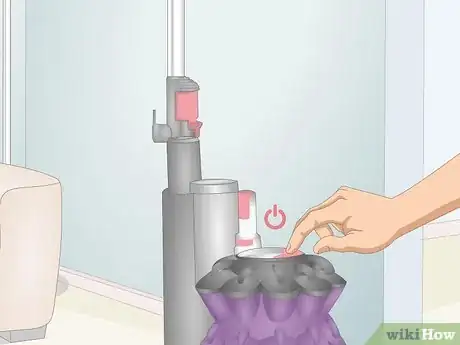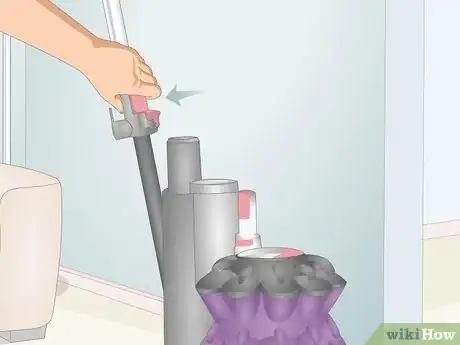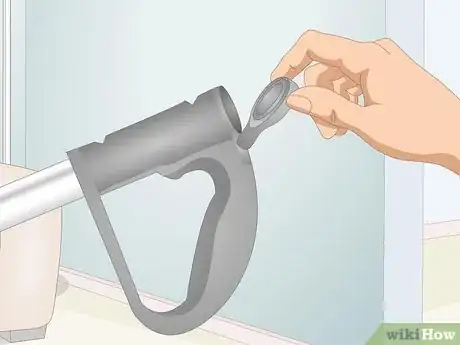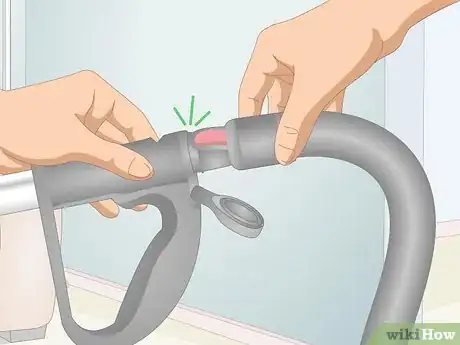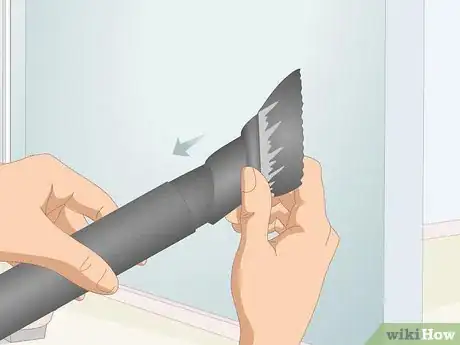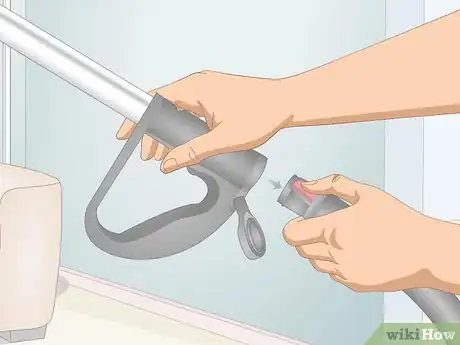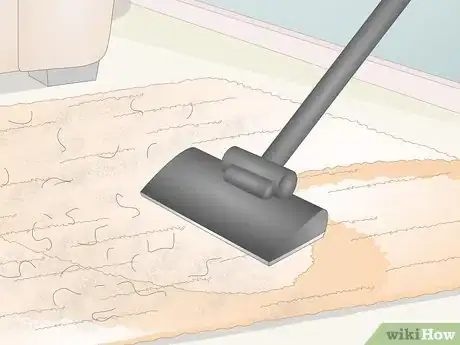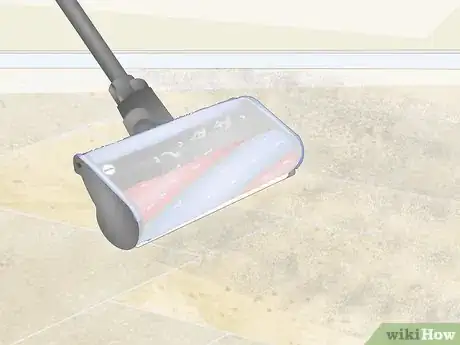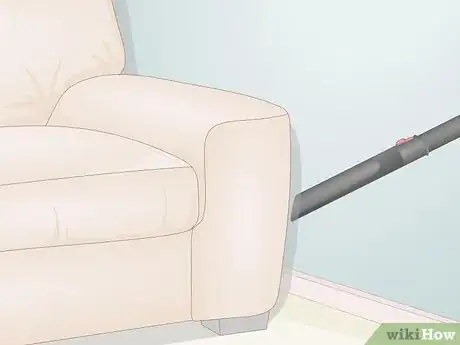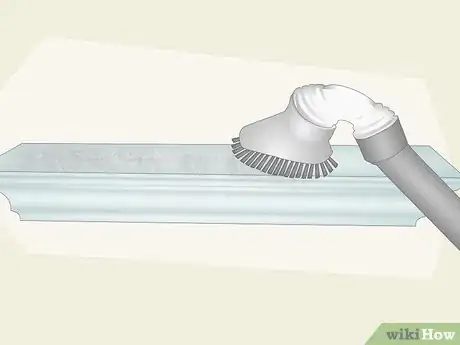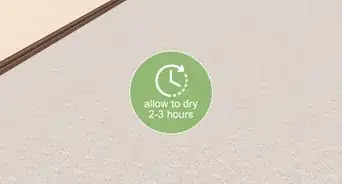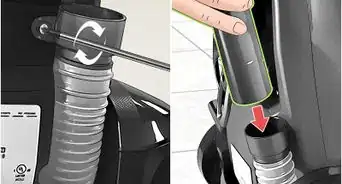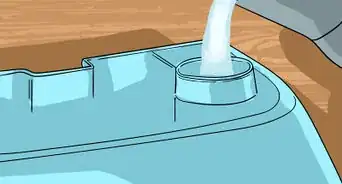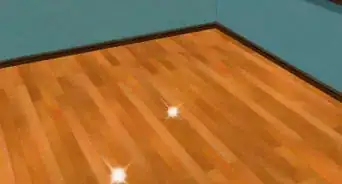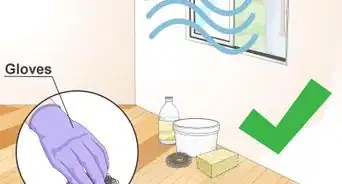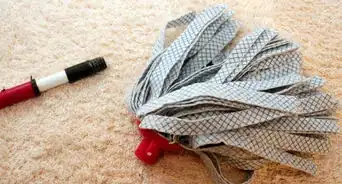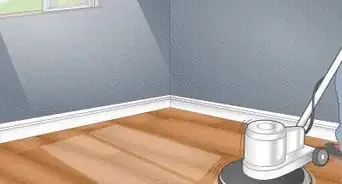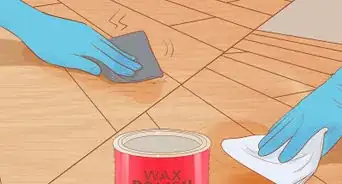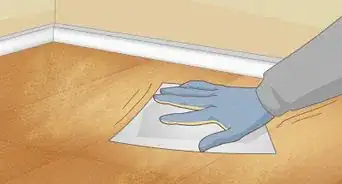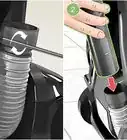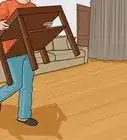This article was co-authored by wikiHow staff writer, Eric McClure. Eric McClure is an editing fellow at wikiHow where he has been editing, researching, and creating content since 2019. A former educator and poet, his work has appeared in Carcinogenic Poetry, Shot Glass Journal, Prairie Margins, and The Rusty Nail. His digital chapbook, The Internet, was also published in TL;DR Magazine. He was the winner of the Paul Carroll award for outstanding achievement in creative writing in 2014, and he was a featured reader at the Poetry Foundation’s Open Door Reading Series in 2015. Eric holds a BA in English from the University of Illinois at Chicago, and an MEd in secondary education from DePaul University.
There are 7 references cited in this article, which can be found at the bottom of the page.
This article has been viewed 66,265 times.
Learn more...
Dyson attachments refer to the interchangeable brushes and tools that lock into the end of your vacuum hose to clean unique surfaces. To put an attachment on your vacuum, press the red button near the base of the handle to release it and turn it into a handheld wand. Connect the hose to the top of the handle and slide your attachment into the opening at the other end of the wand. There are a variety of attachments designed to help you clean carpet, odd angles, pet fur, and sensitive surfaces.
Steps
Putting Attachments on the Vacuum
-
1Turn off the vacuum before changing attachments. Unplug your Dyson vacuum before removing the wand or attaching anything to the head of your hose. If the vacuum is running when you detach the handle, your hose may fly all over the place or knock something over.[1]
- The wand refers to the thin pole extending out of the handle.
-
2Press the red button at the base of the handle to release the wand. On your upright vacuum, press the red button on the back of the machine where the wand meets the frame of the vacuum. This will release the wand and the hose at the same time. Lift the wand out of the vacuum by pulling the handle directly up and pull the hose out with your other hand.[2]
- The hose is attached to the bracket with the red button on it. Simply lift the entire piece out of the vacuum to extend the hose.
Advertisement -
3Flip the plastic cover at the top of the handle. On the top of the handle, there is a plastic cover. Flip this cover up to reveal the opening. Your hose slides into this opening to connect your wand.[3]
-
4Slide the hose into the handle until you hear a clicking sound. Turn your wand around so that the handle is facing the hose and slide the hose into the opening at the top of the handle. Once the hose and wand click into place, they are locked together.[4]
- Turning on your vacuum when the wand is connected to the hose will automatically pull air through the hose instead of the head of the vacuum.
-
5Slide your desired attachment on to the end of the wand. To add any Dyson attachment to your hose, simply slide the opening over the end of the wand. Rotate the attachment as needed to adhere it to the end of the wand. You will not hear a click or anything since the attachment relies on the tension between the 2 openings to stay in place.[5]
Warning: Always hold the wand by the handle, not the tool. Since there usually isn’t anything holding the tool in place, the wand may fly out of your hand if you aren’t holding the handle.
-
6Press the red button again to remove or change attachments. Once you’ve finished using an attachment, press the same red button that you originally pressed. This will unlock the hose from the handle. Slide the hose back into the corresponding slot on your vacuum and flip the wand around again to reinsert your handle.[6]
- The attachment will slide off of the end of your wand if you apply a little pressure.
Selecting Attachments for Unique Surfaces
-
1Use the dusting brush to clean sensitive surfaces. The dusting brush looks like a 4 by 8 in (10 by 20 cm) rectangle with long, soft bristles sticking out of it. Use the dusting brush for window sills with trinkets or plants on them. It’s also a great choice for lampshades, and other sensitive surfaces that are prone to collecting dirt. Run the brush against the surface, using the bristles to knock up dirt as you vacuum.[7]
- Dyson makes a version of this brush with stiffer bristles for firmer surfaces.
- Run the bristles under warm water to rinse them and let your brush air dry when you’re done.
-
2Choose the fiber soft dusting brush to clean fabric surfaces and rugs. The fiber soft dusting brush is a long, thin attachment with carbon fiber lining that keeps sensitive surfaces safe. Use the fiber soft dusting brush to clean drapes, tapestries, mirrors, and blinds. Connect the attachment and run the fiber lining gently over sensitive surfaces to absorb dust and dirt without applying too much pressure to the surface.[8]
- Run the brush under water to rinse it off and let it air dry.
Tip: The fiber soft dusting brush is probably the most useful attachment for common cleaning tasks, but it doesn’t come with the vacuum unless you buy an attachment kit or purchase it separately.
-
3Opt for the turbo brush to clean hair and dirt from durable fabrics. The turbo brush is a motorized attachment with 2 spinning turbines underneath. It looks like a flat rectangle with a clear opening on top. Connect the turbo brush and run it back and forth over deeply-embedded hair and residue on tougher carpet, pet beds, or fabric furniture that isn’t made of velvet or silk. Move the brush back and forth until the mess is completely removed.[9]
- The quick-release stubborn dirt brush is another version of the turbo brush that connects directly to the hose.
- The turbo brush is designed to make it impossible for hair to get tangled in the hose.
-
4Use the mattress tool to absorb dust and dirt in pliable surfaces. The mattress tool looks like a plastic triangle that dips down at a 45-degree angle away from your hose. It is designed to be pushed into softer surfaces without damaging the fabric. Connect the mattress tool and press it into the surface that you’re cleaning. Then, drag the tool over the surface that you’re cleaning to remove the dirt and dust embedded deep into your mattress, fluffy sofa, or pillow.[10]
- The mattress tool is certified as asthma and allergy friendly since it lifts hard-to-reach allergens out of surfaces that you commonly lay or sit on.[11]
-
5Pick one of the flat floor tools for floors and even surfaces. Dyson makes 2 large attachments that are designed for flat surfaces. The articulating floor tool has nylon brushes for absorbing dirt and dust on wood and tile. It also rotates and swivels to make moving it around furniture easier. Alternatively, use the flat floor attachment, which is extremely thin, for cleaning larger areas under furniture. The flat floor attachment will work on carpet or hardwood.[12]
- Dyson advertises that the articulating floor tool will work on carpet as well, but the nylon brush may not work well on thin or sensitive rugs.
Using Attachments for Odd Angles
-
1Opt for the crevice tool to vacuum sharp angles and corners. The crevice tool is a thin length of plastic with a 45-degree opening at the end of the attachment. The small, angular opening makes it easier to clean corners and hard to reach surfaces. Use the crevice tool to clean corners of your floor, ceiling, car interior, or furniture. When using the crevice tool, do your best to hold the angled opening directly against the corner or angle that you’re cleaning.[13]
- You can use the crevice tool on fabric, wood, metal, or stone. However, it won’t do a great job at pulling dirt out of fabric.
- The crevice tool can also be used to vacuum in between cushions without removing them.
- Dyson makes a flexible version of a crevice tool that can be bent to reach behind furniture or obstacles.
-
2Pick the multi-angle brush for sensitive or oddly-shaped surfaces. The multi-angle brush is a modular angle brush with moderately-soft bristles at the end of the angular attachment. It is not entirely flexible, but it can be rotated to face specific angles. Use the multi-angle brush to kick dirt off of baseboards or vacuum the carpet under your furniture. Run the bristles back and forth across a surface to knock dirt up and absorb it in the hose.[14]
- Clean the multi-angle brush by running the bristles under warm water and letting it air dry.
-
3Use the reach under tool to deep clean hard-to-reach surfaces. The reach under tool is a clunky-looking wand with multiple separate attachments. Press the red button at the end of the attachment to extend it and make the extension hose flexible. It also comes with a dusting tool and a W-shaped attachment with a brush. Use the reach under tool to force your brush behind and under appliances, inside air vents, and around light fixtures with odd shapes.[15]
- The reach under tool won’t connect directly to older Dyson hoses. However, it is always sold separately and comes with an adaptor for older machines.
-
4Select the pet grooming tool to brush your furry friends. The pet grooming tool is a small, round attachment with a comb and a filter on it. Use the comb to gently brush your pet’s fur while vacuuming up loose fur, dirt, or dust. The filter will catch any thick clumps of fur, making them easy to pull off once you’re done grooming your pet.[16]
- The grooming tool is probably best suited for dogs since cats tend to jump all over the place at the sound of a vacuum.
- Always brush a pet by combing away from their head.
Warning: Do not use the pet grooming tool on your pet’s face. Avoid using the grooming tool on breeds with wiry fur, like poodles and Bichons.
References
- ↑ https://media.dyson.com/downloads/us/floorcare/manuals/dc14_opmanual_usa2007.pdf
- ↑ https://youtu.be/MacPlRrWqLI?t=14
- ↑ https://media.dyson.com/downloads/us/floorcare/manuals/dc14_opmanual_usa2007.pdf
- ↑ https://media.dyson.com/downloads/us/floorcare/manuals/dc14_opmanual_usa2007.pdf
- ↑ https://media.dyson.com/downloads/us/floorcare/manuals/dc14_opmanual_usa2007.pdf
- ↑ https://media.dyson.com/downloads/us/floorcare/manuals/dc14_opmanual_usa2007.pdf
- ↑ https://www.goodhousekeeping.com/home/cleaning/tips/a25158/vacuum-attachments-explained/
- ↑ https://www.goodhousekeeping.com/home/cleaning/tips/a25158/vacuum-attachments-explained/
- ↑ https://www.goodhousekeeping.com/home/cleaning/tips/a25158/vacuum-attachments-explained/
- ↑ https://www.goodhousekeeping.com/home/cleaning/tips/a25158/vacuum-attachments-explained/
- ↑ https://www.asthmaandallergyfriendly.com/USA/certified_products/dyson-mattress-tool/
- ↑ https://www.dyson.com/vacuum-cleaners/dyson-vacuum-tools/vacuum-tools-uprights.html
- ↑ https://www.goodhousekeeping.com/home/cleaning/tips/a25158/vacuum-attachments-explained/
- ↑ https://www.dyson.com/vacuum-cleaners/dyson-vacuum-tools/vacuum-tools-uprights.html
- ↑ https://youtu.be/thTvysnq1fo?t=150
- ↑ https://youtu.be/XACmQXeykKw?t=164
